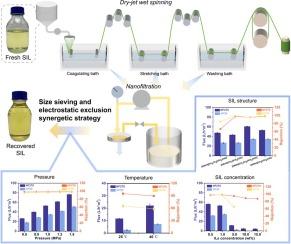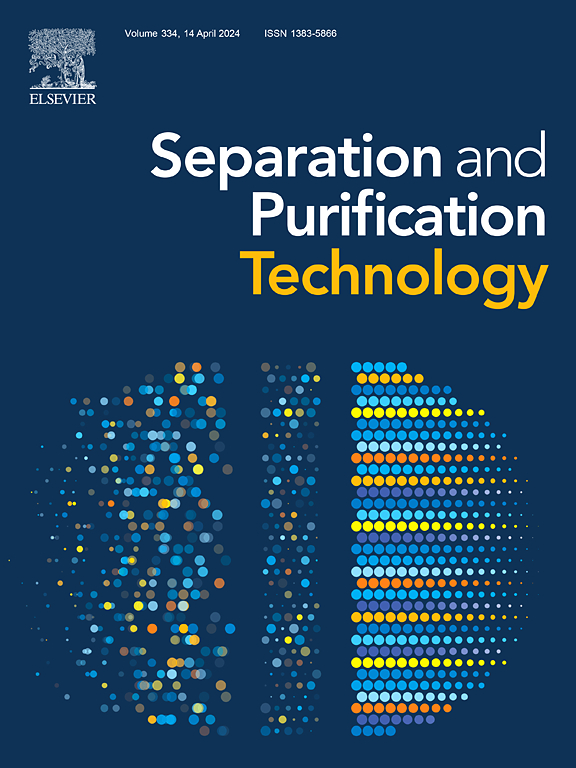尺寸筛分和静电排斥协同策略,通过纳滤从纺丝过程中高效回收超碱衍生离子液体
IF 8.1
1区 工程技术
Q1 ENGINEERING, CHEMICAL
引用次数: 0
摘要
超碱衍生离子液体(SILs)作为纤维素纺丝工艺中极具前景的绿色溶剂,其可回收性亟待深入评估。本文首次采用尺寸筛分和静电排斥协同策略,利用纳滤膜(NF270 和 NF90)从水溶液中回收了四种 SIL([DBUH][CH3CH2OCH2COO]、[DBUH][CH3OCH2COO]、[DBNH][CH3CH2OCH2COO]和 [DBNH][CH3OCH2COO])。与 NF90 相比,NF270 孔径更大,带负电荷更多,因此体积通量更大,对 IL 的截留率明显更高(>95%),有利于回收 SIL。压力和温度的升高对膜的渗透通量起到了积极作用,而 SIL 浓度的升高则明显降低了静电排斥,导致回收效率下降。得益于尺寸筛分效应,阳离子和阴离子结构较小的[DBNH][CH3OCH2COO]由于能隙大、IL聚集体大而得到了有效回收。相反,[DBUH][CH3CH2OCH2COO](能隙低、正电荷密度高)与膜之间出现了强烈的静电吸引,导致回收效率下降。此外,纳滤和蒸发相结合从纺丝废水中回收 SIL 与仅蒸发相比,有效降低了总回收成本(1.51 美元/Kg)。这项工作的启示是,在工业化纤维素纺丝过程中,可以采用一种高效、经济的方法,通过大孔径纳滤膜回收阳离子和阴离子尺寸较小的 SIL。本文章由计算机程序翻译,如有差异,请以英文原文为准。

Size sieving and electrostatic exclusion synergetic strategy for high efficiency recovery of superbase-derived ionic liquids via nanofiltration from the spinning process
Superbase-derived ionic liquids (SILs) as the promising green solvents for cellulose spinning process should be urgently and deeply evaluated with respect to their recyclability. Herein, size sieving and electrostatic exclusion synergetic strategy was adopted for recycling four SILs ([DBUH][CH3CH2OCH2COO], [DBUH][CH3OCH2COO], [DBNH][CH3CH2OCH2COO], and [DBNH][CH3OCH2COO]) from aqueous solutions by the nanofiltration membranes (NF270 and NF90) at the first time. NF270 with larger pore and more negative charge was conducive to recycle SIL on account of a higher volume flux and the remarkably high IL rejection (>95 %) compared to NF90. Rising the pressure and temperature played the positive role in the permeate flux of the membranes, whereas the elevated SIL concentration markedly decreased the electrostatic exclusion, leading to a decline in the recovery efficiency. Benefiting from the size sieving effect, the [DBNH][CH3OCH2COO] with small cation and anion structure could be recovered efficiently due to the high energy gap and big IL aggregates. Conversely, the strong electrostatic attraction was appeared between [DBUH][CH3CH2OCH2COO] (low energy gap and high positive charge density) and the membranes, leading to a decline in recovery efficiency. Furthermore, the combination of nanofiltration and evaporation to recover SIL from spinning wastewater effectively reduced the total recovery cost (1.51 $/Kg) in comparison with the evaporation only. Insight gained from this work suggested a high-efficiency and economical approach could be used in the recovery of SILs with small cations and anions size via large pore nanofiltration membranes during the industrialized cellulose spinning process.
求助全文
通过发布文献求助,成功后即可免费获取论文全文。
去求助
来源期刊

Separation and Purification Technology
工程技术-工程:化工
CiteScore
14.00
自引率
12.80%
发文量
2347
审稿时长
43 days
期刊介绍:
Separation and Purification Technology is a premier journal committed to sharing innovative methods for separation and purification in chemical and environmental engineering, encompassing both homogeneous solutions and heterogeneous mixtures. Our scope includes the separation and/or purification of liquids, vapors, and gases, as well as carbon capture and separation techniques. However, it's important to note that methods solely intended for analytical purposes are not within the scope of the journal. Additionally, disciplines such as soil science, polymer science, and metallurgy fall outside the purview of Separation and Purification Technology. Join us in advancing the field of separation and purification methods for sustainable solutions in chemical and environmental engineering.
 求助内容:
求助内容: 应助结果提醒方式:
应助结果提醒方式:


